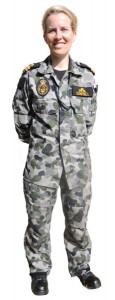Submarine community welcomes Australian sailor
By Lookout on Jun 03, 2016 with Comments 0

Lieutenant (Navy) Regina Campbell.
Rachel Lallouz, Staff Writer ~
Lieutenant (Navy) Regina Campbell isn’t your typical Maritime Forces Pacific submariner.
She hails from the warm, and much saltier waters off the western coast of Australia as a member of the Royal Australian Navy (RAN) based in Perth.
She is on an exchange program with the Royal Canadian Navy (RCN), and in the summer will join HMCS Chicoutimi.
“Submarines are a fascinating field because the aim of a defence force, in my understanding, is to train to such a level that you are a deterrent force – you prevent attacks and therefore maintain peace.
But submarines are a strategic weapon,” she says. “It’s a completely different ballgame and a very challenging environment.”
She joined the RAN at age 27, in 2007, and officially became a submariner a few years later.
The journey to her Dolphin badge was no easy feat, she says.
“You start off with your basic medical and psychological assessments, and then submarine basics, all the while officers keep a constant eye on you to make sure you fit in well in a small environment.
Then there’s six months of school on submarine engineering and operational background.”
From there, Lt(N) Campbell says she had to complete four information-filled task books and deploy before gaining her “dolphins” and be deemed certified as a safe submariner.
She later worked her way to the position of Sonar Officer on board Australian submarine HMAS Dechaineux.
Her first time deployed on a submarine was a day tour in 2010 off Sydney.
“I remember the first day setting foot on a submarine. I’ll never forget it.
I entered this very small microcosm where everyone seemed to know exactly what they were doing. It was exciting and intimidating.”
Initially educated as a journalist, Lt(N) Campbell never anticipated she would one day end up working as a submariner, but looking back, she says there were clues in her childhood.
“Three years ago my mom found an old science project of mine that detailed how submarines work, showing the periscope and all the main parts,” she recalls.
In Canada, she will fulfill the role of an Officer of the Watch while the submarine is surfaced and dived.
So far, Lt (N) Campbell has spent time training on emergency operating procedures at the submarine simulator located in Halifax. She is currently preparing for her first long-term sail in a RCN submarine.
She has most enjoyed how welcoming and warm Canadian military members have been.
“Being a submariner means living a very extreme lifestyle,” says Lt(N) Campbell.
“It’s either the worst or best day of your life when you’re out there. There doesn’t seem to be much in-between, so it’s always a great surprise as to what the day is going to be.”
Lt(N) Campbell is often only one of a few women on board a sail.
“You end up forgetting that you’re any different. You’re showering once every four days, not looking in a mirror. You get treated exactly the same, and I have dozens of brothers now,” she says.
She is working towards becoming an executive officer onboard a submarine, and says any other goal is a very difficult to gauge as it requires the completion of the submarine command course Perisher, arguably one of the most intense courses in the navy.
“For now, I’m looking forward to training in the different environment Canada has to offer. I’m used to hot weather and keeping certain depths; here there’s cold water and ice. It’s going to be a very different playground.”
Filed Under: Top Stories
About the Author:





